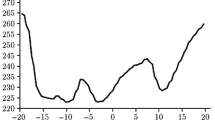Abstract
Kinetics of dissociation of synthetic and natural methane gas hydrates, and also double isopropanol-methane hydrate is investigated. Thermal fields of the sample surfaces are measured by means of thermal imaging in combustion of released methane with clathrate dissociation. The dissociation rates of natural hydrate and double hydrate with isopropanol are many times lower than those of synthetic methane hydrate. Methane combustion is accompanied by formation of a thin water film on the powder surface, which has a strong effect on the heat and mass transfer mechanisms. The experiments demonstrated partial self-preservation for methane hydrate and the absence of self-preservation for double isopropanol-methane hydrate. The experimentally observed dissociation rate of double isopropanol-methane hydrate is considerably lower than that of methane hydrate.
Similar content being viewed by others
References
Ostergaard, K.K., Tohidi, B., Anderson, R., Todd, A.C., and Danesh, A., Can 2-Propanol Form Clathrate Hydrates?, Ind. Eng. Chem. Res., 2002, vol. 41, pp. 2064–2068.
Maekawa, T., Equilibrium Condition for Clathrate Hydrates Formed from Methane and Aqueous Propanol Solution, Fluid Phase Equil., 2008, vol. 267, no. 1, pp. 1–5.
Mohammadi, A. and Richon, D., Experimental Gas Hydrate Dissociation Data for Methane, Ethane, and Propane+2-Propanol Aqueous Solutions and Methane+1-Propanol Aqueous Solution Systems, J. Chem. Eng. Data, 2007, vol. 52, no. 6, pp. 2509–2510.
Zhurko, F.V., Manakov, A.Yu., and Kosyakov, V.I., Formation of Gas Hydrates in the Systems Methane-Water-ROH (ROH = Ethanol, n-Propanol, i-Propanol, i-Butanol), Chem. Eng. Sci., 2010, vol. 65, pp. 900–905.
Istomin, V.A. and Yakushev, V.S., Gazovye gidraty v prirodnykh usloviyakh (Gas Hydrates in Natural Conditions),Moscow: Nedra, 1992.
Sum, A.K., Koh, C.A., and Sloanm E.D., Clathrate Hydrates: From Laboratory Science to Engineering Practice, Ind. Eng. Chem. Res., 2009, vol. 48, pp. 7457–7465.
Cameron, I., Baker, T.H., and Handa, Y.P., Compressive Strength and Creep Behavior of Hydrate Consolidated Sand, Can. Geotech. J., 1989, vol. 28, pp. 235–242.
Cha, S.B., Ouar, H., and Wildeman, T.R., Third-Surface Effect on Hydrate Formation, J. Phys. Chem., 1988, vol. 92, no. 23, pp. 6492–6494.
Kuhs, W.F., Genov, G., Staykova, D.K., and Hansen, T., Ice Perfection and Onset of Anomalous Preservation of Gas Hydrates, Phys. Chem. Chem. Phys., 2004, vol. 6, pp. 4917–4920.
Takeya, S., Ebinuma, T., Uchida, T., Nagao, J., and Narit, H., Self-Preservation Effect and Dissociation Rates of CH4 Hydrate, J. Cryst. Growth, 2002, nos. 237–239, pp. 379–382.
Falenty, A. and Kuhs, W.F., Self-Preservation of CO2 Gas Hydrates-Surface Microstructure and Ice Perfection, J. Phys. Chem. B, 2009, vol. 113, pp. 15975–15988.
Stern, L.A., Circone, S., Kirby, S.H., and Durham, W.B., Anomalous Preservation of Pure Methane Hydrate at 1 atm., J. Phys. Chem. B, 2001, vol. 105, pp. 1756–1762.
Melnikov, V.P., Nesterov, A.N., Reshetnikov, A.M., and Istomin, V.A., Metastable States during Dissociation of Carbon Dioxide Hydrates below 273 K, Chem. Eng. Sci., 2011, vol. 66, pp. 73–77.
Takeya, S. and Ripmeester, J.A., Anomalous Preservation of CH4 Hydrate and Its Dependence on the Morphology of Ice, Chem. Phys. Chem., 2010, vol. 11, pp. 70–73.
Nakoryakov, V.E., Misyura, S.Ya., Elistratov, S.L., Manakov, A.Yu., and Shubnikov, A. E., Combustion of Hydrates, J. Eng. Therm., 2013, vol. 22, no. 2, pp. 1–6.
Maruyama, Y., Yokomori, T., Ohmura, R., and Ueda, T., Flame Spreading over Combustible Hydrate in a Laminar Boundary Layer, 7th Int. Conf. on Gas Hydrates (ICGH 2011), Edinburgh, Scotland, United Kingdom, July 17–21, 2011.
Takeuchi, M., Ueda, T., Amari, T., and Mizomoto, M., Stability of Diffusion Flame Formed in a Laminar Flat Plate Boundary Layer (Effect of Fuel Dilution), Trans. JSME, 1998, vol. 64, no. 626, pp. 3485–3490.
Nakamura, Y., Katsuki, R., Yokomori, T., Ohmura, R., Takahashi, M., Iwasaki, T., Uchida, K., and Ueda, T., Combustion Characteristics of Methane Hydrate in a Laminar Boundary Layer, Energy Fuels, 2009, vol. 23, pp. 1445–1449.
Author information
Authors and Affiliations
Corresponding author
Rights and permissions
About this article
Cite this article
Nakoryakov, V.E., Misyura, S.Y., Elistratov, S.L. et al. Methane combustion in hydrate systems: Water-methane and water-methane-isopropanol. J. Engin. Thermophys. 22, 169–173 (2013). https://doi.org/10.1134/S1810232813030016
Received:
Published:
Issue Date:
DOI: https://doi.org/10.1134/S1810232813030016




